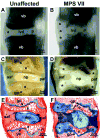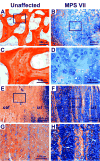Altered lumbar spine structure, biochemistry, and biomechanical properties in a canine model of mucopolysaccharidosis type VII
- PMID: 19918911
- PMCID: PMC2975604
- DOI: 10.1002/jor.21030
Altered lumbar spine structure, biochemistry, and biomechanical properties in a canine model of mucopolysaccharidosis type VII
Abstract
Mucopolysaccharidosis VII (MPS VII) is a lysosomal storage disorder characterized by a deficiency in beta-glucuronidase activity, leading to systemic accumulation of poorly degraded glycosaminoglycans (GAG). Along with other morbidities, MPS VII is associated with pediatric spinal deformity. The objective of this study was to examine potential associations between abnormal lumbar spine matrix structure and composition in MPS VII, and spine segment and tissue-level mechanical properties, using a naturally occurring canine model with a similar clinical phenotype to the human form of the disorder. Segments from juvenile MPS VII and unaffected dogs were allocated to: radiography, gross morphology, histology, biochemistry, and mechanical testing. MPS VII spines had radiolucent lesions in the vertebral body epiphyses. Histologically, this corresponded to a GAG-rich cartilaginous region in place of bone and elevated GAG staining was seen in the annulus fibrosus. Biochemically, MPS VII samples had elevated GAG in the outer annulus fibrosus and epiphyses, low calcium in the epiphyses, and high water content in all regions except the nucleus pulposus. MPS VII spine segments had higher range of motion and lower stiffness than controls. Endplate indentation stiffness and failure loads were significantly lower in MPS VII samples, while annulus fibrosus tensile mechanical properties were normal. Vertebral body lesions in MPS VII spines suggest a failure to convert cartilage to bone during development. Low stiffness in these regions likely contributes to mechanical weakness in motion segments and is a potential factor in the progression of spinal deformity.
Copyright (c) 2009 Orthopaedic Research Society.
Figures







Similar articles
-
Delayed hypertrophic differentiation of epiphyseal chondrocytes contributes to failed secondary ossification in mucopolysaccharidosis VII dogs.Mol Genet Metab. 2015 Nov;116(3):195-203. doi: 10.1016/j.ymgme.2015.09.008. Epub 2015 Sep 26. Mol Genet Metab. 2015. PMID: 26422116 Free PMC article.
-
Pathogenesis of lumbar spine disease in mucopolysaccharidosis VII.Mol Genet Metab. 2012 Sep;107(1-2):153-60. doi: 10.1016/j.ymgme.2012.03.014. Epub 2012 Mar 30. Mol Genet Metab. 2012. PMID: 22513347 Free PMC article.
-
Effect of neonatal gene therapy on lumbar spine disease in mucopolysaccharidosis VII dogs.Mol Genet Metab. 2012 Sep;107(1-2):145-52. doi: 10.1016/j.ymgme.2012.03.013. Epub 2012 Mar 29. Mol Genet Metab. 2012. PMID: 22510705 Free PMC article.
-
Murine mucopolysaccharidosis type VII: the impact of therapies on the clinical course and pathology in a murine model of lysosomal storage disease.J Inherit Metab Dis. 1998 Aug;21(5):575-86. doi: 10.1023/a:1005423222927. J Inherit Metab Dis. 1998. PMID: 9728337 Review.
-
[Biomechanics of the intervertebral disc : Consequences of degenerative changes].Orthopadie (Heidelb). 2024 Dec;53(12):912-917. doi: 10.1007/s00132-024-04578-4. Epub 2024 Nov 5. Orthopadie (Heidelb). 2024. PMID: 39499289 Review. German.
Cited by
-
Progression of vertebral bone disease in mucopolysaccharidosis VII dogs from birth to skeletal maturity.Mol Genet Metab. 2021 Aug;133(4):378-385. doi: 10.1016/j.ymgme.2021.06.005. Epub 2021 Jun 15. Mol Genet Metab. 2021. PMID: 34154922 Free PMC article.
-
Delayed hypertrophic differentiation of epiphyseal chondrocytes contributes to failed secondary ossification in mucopolysaccharidosis VII dogs.Mol Genet Metab. 2015 Nov;116(3):195-203. doi: 10.1016/j.ymgme.2015.09.008. Epub 2015 Sep 26. Mol Genet Metab. 2015. PMID: 26422116 Free PMC article.
-
Postnatal progression of bone disease in the cervical spines of mucopolysaccharidosis I dogs.Bone. 2013 Jul;55(1):78-83. doi: 10.1016/j.bone.2013.03.014. Epub 2013 Apr 4. Bone. 2013. PMID: 23563357 Free PMC article.
-
The effect of neonatal gene therapy on skeletal manifestations in mucopolysaccharidosis VII dogs after a decade.Mol Genet Metab. 2013 Jun;109(2):183-93. doi: 10.1016/j.ymgme.2013.03.013. Epub 2013 Apr 6. Mol Genet Metab. 2013. PMID: 23628461 Free PMC article.
-
Comparison of growth dynamics in different types of MPS: an attempt to explain the causes.Orphanet J Rare Dis. 2022 Sep 5;17(1):339. doi: 10.1186/s13023-022-02486-4. Orphanet J Rare Dis. 2022. PMID: 36064607 Free PMC article.
References
-
- Sly WS, Quinton BA, McAlister WH, Rimoin DL. Beta glucuronidase deficiency: report of clinical, radiologic, and biochemical features of a new mucopolysaccharidosis. J Pediatr. 1973;82:249–257. - PubMed
-
- Beaudet AL, DiFerrante NM, Ferry GD, et al. Variation in the phenotypic expression of beta-glucuronidase deficiency. J Pediatr. 1975;86:388–394. - PubMed
-
- Vogler C, Levy B, Kyle JW, et al. Mucopolysaccharidosis VII: postmortem biochemical and pathological findings in a young adult with beta-glucuronidase deficiency. Mod Pathol. 1994;7:132–137. - PubMed
Publication types
MeSH terms
Substances
Grants and funding
LinkOut - more resources
Full Text Sources

